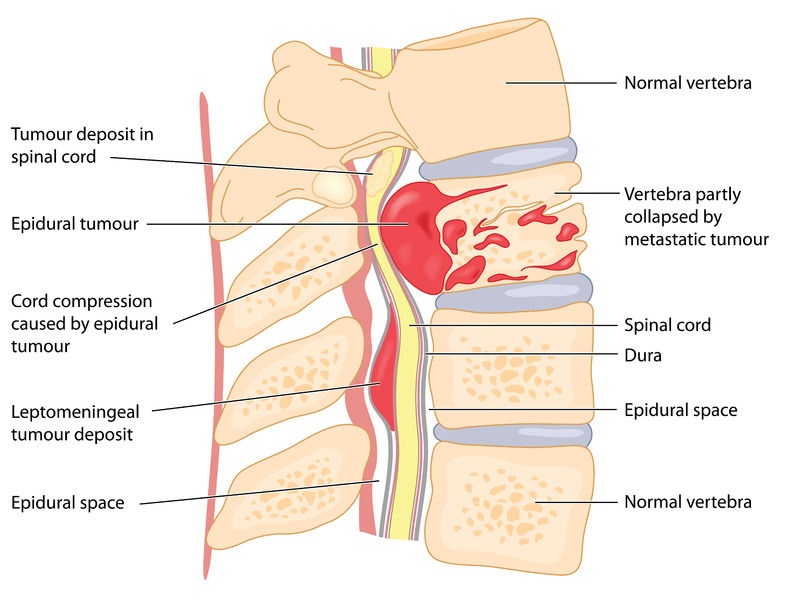Spine Tumor Surgery/ Treatment In Mumbai
The fundamentals of spinal tumors:
Spinal tumors are abnormal growth of cells in and around the spinal cord. Spinal tumors are commonly due to deposits of cancer cells from elsewhere in the body, secondary/metastatic tumors, rather than primary tumors which arise from the spinal tissue itself. These tumors can be of two types, benign or malignant.
Spinal tumors are classified according to the region where they are found such as cervical, thoracic, lumbar or sacral tumors as well as their location within the spine such as intradural-extra-medullary, intramedullary and extradural.
The most common types of intradural-extramedullary tumor to affect the adult population are meningiomas, neurofibromas and ependymomas. Of the intramedullary type, the most common tumors are gliomas, ependymomas and lipomas. The most common extradural tumors are usually secondary deposits from elsewhere in the body or they can be schwannomas.
Primary spinal tumors are very rare, and the incidence is only around one spinal tumor for every intracranial tumor which occurs.
The causes: Although the cause for many of the primary spinal tumors remain unknown, some tumors such as spinal cord lymphomas are thought to arise as a result of a compromised immune system. The presence of genetic conditions such as Neurofibromatosis 2 and Von Hippel-Lindau Syndrome has been associated with the development of spinal tumors.
When should I suspect that I have spinal cord tumor?
There a set of common symptoms, which patients who have been plagued by spinal tumors commonly complaint of. These include:
What are the treatment options available for spinal tumors?
Your treatment options for spine tumors include non-surgical methods and surgical methods. Non-surgical methods include radiotherapy and chemotherapy. Sometimes if the tumor has been found accidentally while investigating for other conditions, is still in its early stages and is not causing symptoms or disability, then watchful waiting, to see if it is growing bigger is also a form of treatment that some doctors may suggest. Because the risks of living with a tumor which is not growing outweighs the risks of undergoing surgery.
Radiation therapy is often used to treat metastatic spinal tumors or secondary deposits. It involves delivering doses of high energy radiation to those areas of the body affected by the tumor cells, in order to destroy the cells. The latest method of delivering radiation therapy uses an instrument called the cyber knife which uses a robotic arm in order to deliver focused high dose radiation to the spinal cord, and is thought to be extremely useful because of the flexibility of the arm, which makes it all the more precise.
Chemotherapy makes use of chemicals which are either taken orally or injected into a vein, which are then taken up by the tumor cells and causes slow destruction of these cells.
A variety of surgical methods are available for the treatment of spinal tumors. Which of these procedures a patient undergoes, will be decided by the doctor, depending on factors such as the type of spinal tumor the patient has, the exact location and size of it as well as patient factors such as the age and general health status of the patient. The different types of surgical procedures include:
How safe is surgery for spinal tumors?
Spinal surgery has evolved in more ways than one over the years. The advancement of technology and the availability of precision tools as well accurate imaging techniques, has led to development of unique surgical procedures which allow surgeons to access the spinal cord in less invasive ways than before. And even though there still is some risk involved with it, surgeons are able to keep it down to a minimum
As a result of which surgeons are able to perform more and more successful surgeries, which help the patients get back their quality of life. Because more than the risks involved with spinal surgery, the risks of opting out of surgery can be catastrophic to the patient, as it can end up with vertebral fractures and collapse, leading to spinal cord compression and even partial paralysis. So excision of the tumor at the right time is of utmost importance, and if you have the chance of getting rid of it once and for all, as is the case with benign tumors, then you couldn’t ask for more !
How different is spinal surgery from other surgeries performed?
All major surgeries will carry with them a certain amount of risk, because it involves general anesthesia, being unconscious for the duration of the surgery, an incision being made in your body and the insertion of instruments into your body. So any major surgery performed in any part of your body, will be a tough decision to make.
Spinal surgeries are different because they don’t involve a very large incision, and surgeons are always trying to make it as minimally invasive as possible, with the use of the most accurate tools making spinal surgeries much safer than they were in the days gone by. The risk of extensive bleeding which is present with other surgeries is minimal when compared to spinal surgeries because there are no major blood vessels which can easily be punctured during the surgery.
Since the symptoms of a spinal tumor can be very debilitating and distressing for the patient, more and more people are currently opting to undergo spinal tumour excision surgery, because they want to have a good quality of life.




